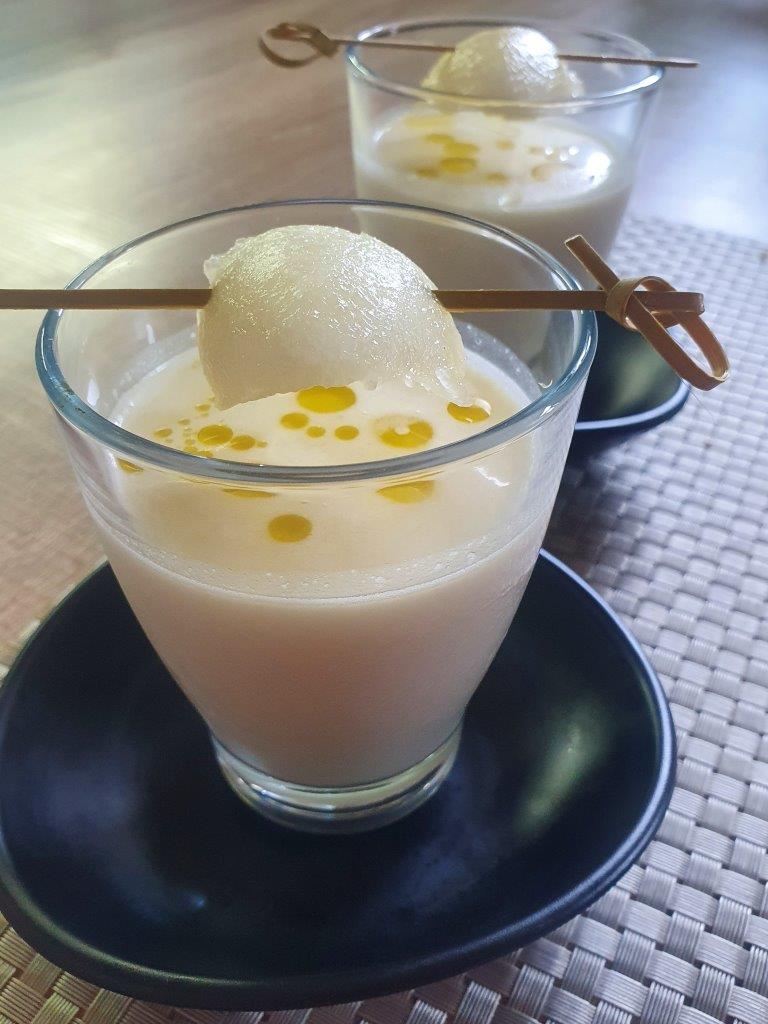Ajoblanco, which translated means white garlic, is one of the most popular variations of gazpacho, and like gazpacho it comes from Andalucía, mainly Granada and Malaga, but it is also common in Extremadura and Huelva.
Although you could be forgiven for thinking that the star ingredient is garlic, you can make it with less, or without it, if garlic is not of your liking, this peasant recipe’s main ingredient is blanched almonds, and there are records of poorer areas where the almonds were replaced by dry broad bean flour. Ajoblanco can be traced back to some popular Roman soups made of vinegar, oil and bread, all in equal parts, but there is no doubt that it was the Arab cuisine, with its widespread use of almonds, that definitely influenced this recipe to take it into what we know today.
Andalusia was, and still continues to be, an agricultural region and peasants worked under the harsh Andalusian sun, which is why the rich culture of cold soups developed in the area. They were nutritious, refreshing, and kept you from dehydrating, helping the labourers to resist the long hours working in the fields. I’ve certainly made good use of them over the frequent heat waves so far this summer.

In Spain there are festivities dedicated to ajoblanco. In Malaga on 2nd September, there are official tastings and competitions and likewise, in Herrera del Duque (Badajoz, Extremadura) there is an ajoblanco contest on 15th August. In fact, in the town of Herrera del Duque, they also have their own separate version of the dish that uses croutons and replaces the almonds with two egg yolks. This version is normally eaten during the colder months as it provides people with more calories to sustain them throughout the winter. In Granada, ajoblanco soup is normally eaten with a good ‘papa asá’, a baked potato. Meanwhile in Malaga, it is often accompanied by a selection of fruit such as moscatel grapes and pieces of apple or melon. Fruit, and this cold soup, go incredibly well together and this makes it extremely refreshing. Of course you could actually add some melon or apple to the blender when mixing the soup together to make slight variations of it.
In essence, no matter what kind of menu you are planning, you can always count on ajoblanco to fit in there, and it can be served as a starter, a main meal with other fruits, bread, serrano ham and cheese, or in a shot glass as an appetizer. Here you would add a little more water and even unsweetened almond milk to make it easier to drink from the glass. Vegan nutrition in a glass, given the beneficial properties of the almonds, garlic and olive oil, this is a must for the summer months

Ajoblanco takes no time to make but it really does benefit from an overnight stay in the fridge. The ingredients are not cooked so it definitely helps the flavours to blend together and some to take over. I jokingly call this cold cooking!
There isn’t really a rule to make ajoblanco, and each cook prepares it to his or her liking, but there are general guidelines that you can follow and experimenting is key. You could even prepare a batch which is then separated into smaller portions and variations and adjustments can be made to each, for example increasing the quantity of a particular ingredient or adding a particular fruit.
So down to the basics, although as I always say, use more or less of your ingredients of choice. The end result will be slightly different but it may well be more suited to your tastes.

You will need a chunk of stale white bread, crusts removed, about 100 grams, about 60 grams blanched almonds, at least 2 garlic cloves, 5 tablespoons of good extra virgin olive oil, 1 tablespoon of Sherry Vinegar, or flavoured vinegar of your choice, and 1 – 1½ cups cold water to make the basic soup.
You start by soaking the bread in cold water, or almond milk which works really well, and then place the almonds in a food processor to process them until finely ground. This of course was always done by hand before, and either method works well. Once the almonds are ground, and the bread has softened, you add this to the processor along with the garlic and process until combined, and then add the water to obtain a smooth mixture. With the blender, you then trickle in the olive oil, one tablespoon at a time, as if you were making mayonnaise, and then once all the oil has been added, you trickle in the sherry vinegar.
I always pour this into a glass container and refrigerate overnight, adjusting flavours once the mixture has had an opportunity to blend well. I usually find that I may want to add a little more salt, vinegar or olive oil, although I always drizzle it with very good quality olive oil when I serve it. You will of course also adjust the consistency by adding water or unsweetened almond milk should you want to have a less creamy version.

To serve there are no limits, and as long as the soup is cold, and the other ingredients are fresh, it will be more than enjoyable.
As I write, I have visions of a refreshing bowl of ajoblanco, accompanied by grilled, caramelised figs, in season now of course, drizzled with some honey, or maple syrup to keep it vegan.
Text And Photography By Mark Montovio




